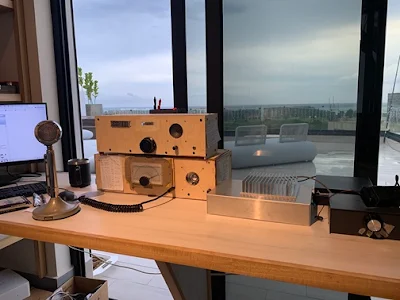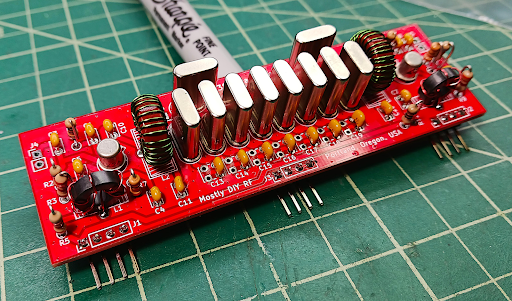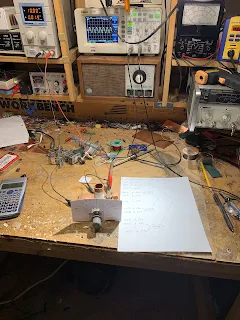Fires in LA.
Dean: Breaking the Barkhausen criteria.
Seeing the Southern Cross for the first time in 30 years.
For all three of us: The SolderSmoke Homebrew Challenge. And assembling a kit. https://soldersmoke.blogspot.com/2025/01/some-history-of-homebrew-ham-radio-from.html
https://soldersmoke.blogspot.com/2025/01/the-magic-that-only-comes-from-radio.html
https://soldersmoke.blogspot.com/2025/01/steve-g0fuw-talks-homebrew-and-kits.html
________________________________
Bill's (Southern) Bench:
-- SKN with QCX given to me by Bob. Thanks Bob!
-- Finishing up the AN762 .1kW amplifier. Socketry and relays. Working well.
-- A tale of woe: Some difficult troubleshooting on the 15-10 rig. Intermittent oscillation. Naturally I blamed the TJ DC RX AF amp. Spent a lot of time working on that amplifier. But problem always returned. Started looking at output from carrier osc/BFO. Waveform weird. Then weirdness disappeared and so did the whooping. So I rebuilt the entire carrier osc/BFO/ mixer board. Went back to singly balanced 2 diode mixer. Used LTSpice for the oscillator amp.. No more whooping. Turning the diodes on and off but not quite 7 dbm... Should I be concerned?
-- A 10 meter beacon! 28.233 Please listen. Send e-mail reports. Thanks to WN2A.
-- Antenna thoughts. Getting a tripod.
_______________________________
SHAMELESS COMMERCE! Mostly DIY RF! Lots of useful kits and boards there. I have used their TIA boards. Todd K7TFC is one of us. FB store.
Become a SolderSmoke patron. We need the help. Homebrew is under seige! We are one of the few sites, blogs, podcasts that are promoting it! Help us!
Buy stuff from Amazon and E-bay using the links on our sites.
------------------------------------------------
Dean's Bench:
-- ARRL kids day -- Exhausting.
-- VWS Makers SDR receiver build.
-- High School DC RX Build news. How to watch the videos.
_______________________________
Pete's Bench:
-- Hacked!
-- Power Alternatives.
-- Thermatron Finals
-- KWM-4.
__________________________
Mailbag
Dave Newkirk W9BRD (son of Rod). Great comments on homebrew radio. And a great picture.
Derek N9TD built the DC Receiver. FB Derek!
Peter VK2EMU at 39C in Australia. HOT!
Drew N7DA -- Some great comments on kits vs. homebrew.
Tommy SA2CLC has a nice video about fixing the cavity resonator in his HP8640. Respect!
Ben KC9DLM sent good presentation from India: https://github.com/kholia/talks/blob/master/Dhiru_My_RF_Homebrew_Adventures.pdf
Scott KQ4AOP and Derek N9TD offering to 3D Print PTO coil forms. FB!
Donnie WA9TGT on the beautiful signals from DC receivers.
Chuck KE5HPY's FB Altoids DC receiver.
Todd VE7BPO: POPCORN ELECTRONICS IS BACK! Thanks Todd. And thanks Vasily!
Jim KA4THC has his uBITX on the air and is making contacts!
Farhan VU2ESE fond memories of homebrew dinner with Wes and other HB Heroes (on the blog).
Charlie ZL2CTM -- About his new Pelican Case SSB rig.
Walter KA4KXX. All new hams should build a transmitter.
Buzz W3EMD A nice QSO on 10 and then a shout out to the Old Military Radio Net



.jpg)




















.jpg)














